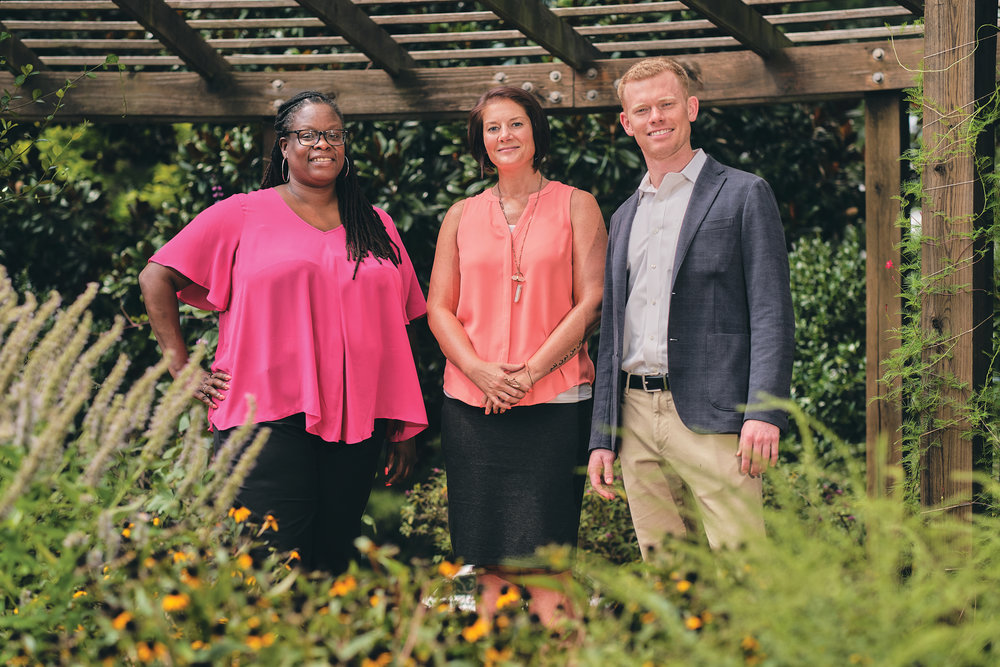At Healing Transitions,
unconditional hope leads the way.
By Beth Peterson / Photo by Josh Manning / Jericho 7 Films
What does addiction look like? To be honest, it looks a lot like me. And it looks like you. In fact, if asked to describe the type person most likely to use substances, you’d have to stop at “human,” without getting any more specific. Regardless of race, religion, gender, socioeconomic background, or upbringing, addiction is an equal-opportunity disease. In fact, Amanda Blue, director of programs at Healing Transitions, a Raleigh-based long-term recovery program, says addiction is a disease that does not discriminate in any capacity.
At both the men’s and women’s campuses, participants in the Healing Transitions addiction recovery program quickly discover that hope also does not discriminate. Here, hope is offered in equal—and unlimited—opportunity. Unlike many rehabilitation programs that focus on behavior management, Healing Transitions is a place for second, third, sometimes even eleventh, chances. Regardless of the number of failed attempts at breaking free from addiction’s grip, the courageous decision to ask for help will be met every single time with hope and with help. “As many times as it takes, as long as it takes” is a phrase you’ll hear within the first five minutes of a visit to either campus. “Recovery is almost never a one-time event. It’s a process,” Blue states.
Aptly named, Healing Transitions is filled with individuals in transition. Everyone moves at his or her own pace on the road to recovery, and no one is rushed through the program. Some are here for a night, looking only for a safe place to sleep. Some walk in and walk right out again, not quite ready to commit to the hard work involved in recovery. Others make progress towards recovery, stay several months, and then leave. But anyone who returns to try again is welcomed back, without judgement and without shame.
That judgement-free response is due in large part to Healing Transitions’ peer-to-peer program model. No one judges, because almost everyone here has “been there, done that.” Peer-to-peer means that Healing Transitions relies on people who know what recovery entails; it is not a clinical program staffed with an army of professional therapists overseeing the entire recovery process. Instead, most of the program is led by men and women who are also at varying stages of recovery. With every step toward recovery, participants turn around to encourage the next person: “If I can do this, you can do this.”
The power of the peer-to-peer model impacted alumni Justin Garrity, who recalls a moment from his first few days at Healing Transitions: “There were people six months ahead of me [in the program], and they were laughing. You think, ‘Man, I remember what that was like; I’d like to laugh again.’”
The hope modeled to Justin, that he could laugh again someday, is part of what motivated him through his recovery. Justin has returned to Healing Transitions as the rapid response administrator. He also leads the Oak City Recovery Run Club. “When you’re running, you’re not an addict who lives in a homeless shelter, you’re just ‘Justin,’” Garrity says. “We’re hoping to bust the stigma, and show people that you’re not your disease. Addiction is a disease of isolation,” he adds, “and you beat the disease through connection.”
Tracy Freeman, also employed at Healing Transitions as planning room supervisor, recalls her early days in recovery. Coming to Healing Transitions, she had already been through two recovery programs without success. The difference for Tracy was the commitment made to her by her peers in the program. It was uncomfortable at times, as her peers pointed out the need for change in certain areas of her life, including her tendency to isolate herself. “I was quiet; I tried to fly under the radar. My peers would not let me; they loved me until I could love myself.” She was also urged to build relationships. “I made long-term relationships, and we are still friends today. They notice when I’m having a rough day.”
Healing Transitions is a place of connection; individuals recovering here are constantly and simultaneously reaching back to help the one behind or reaching forward for support from the one ahead. Thorough and thoughtful peer review coupled with clear and graduated steps to recovery are part of the reason that 76 percent of the program’s graduates remain substance-free after one year.
Healing Transitions never refuses help to anyone; they never turn anyone away. And it’s completely free. But, Amanda Blue explains, “As the population increases, it will be hard to keep up.” Over the last 18 years, Healing Transitions has seen a 186 percent increase in its average daily census. In order to meet the needs of Raleigh’s booming population and to continue to do battle against America’s growing opioid crisis, Healing Transitions has launched its capital campaign, Recovery Can’t Wait. An estimated $11.75 million is needed for expansions at both campuses. Please visit Healing-Transitions.org for more information.

